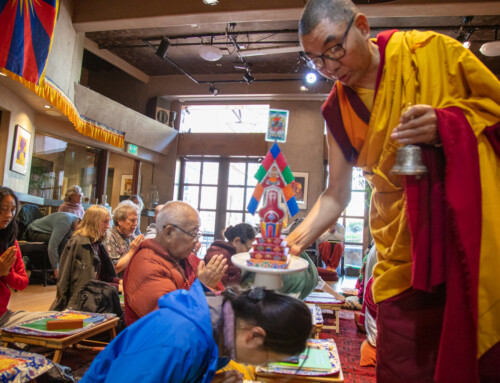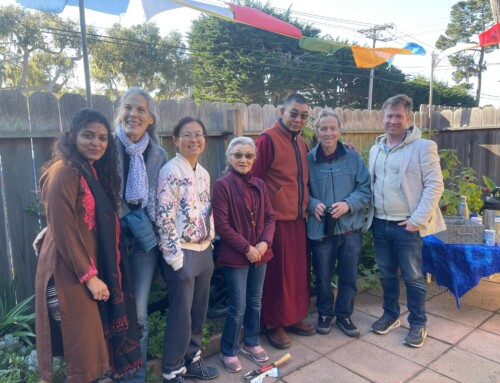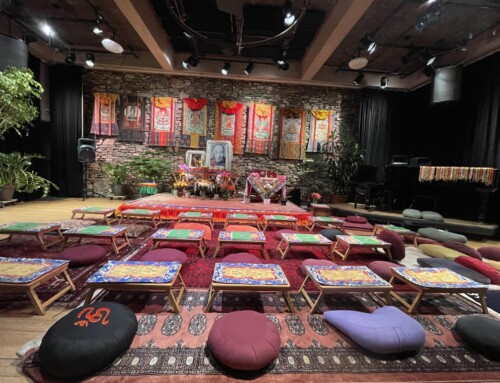The production and disintegration of phenomena
You taught us as the way of interdependence.
This teaching and you, O Buddha, are unexcelled in this world.
I prostrate to you from the depths of my heart.
O people who aspire to meditate these days!
If you would like to do an excellent meditation,
There is great benefit in repeatedly contemplating
The impermanence and disintegration of things!
It reverses attachment to samsara,
Takes the fear out of death
And spurs us to practice holy Dharma:
There is no meditation that surpasses it!
Therefore, even though I am busy,
I have written about impermanence,
This essential meditation, for the benefit of beginners
Everyone! Please cherish its practice!
In this twenty-first century when there has been tremendous advancement in science and technology, many people feel bereft of happiness and are looking for alternatives. Many have become interested in the meditations taught by Buddha, and mindfulness meditation has become highly regarded for its restorative effect on the body and mind.
Among those who practice Buddhadharma, as well, there are many systems and methods, when it comes to meditation. In Shravakayana countries such as Thailand, Burma, and Sri Lanka they meditate on mindfulness, the thirty-seven wings of enlightenment, the eight-fold noble path, the twelve links of interdependence, the four noble truths, and so forth.
In the Buddhism of China, Korea, Japan, Vietnam, Taiwan, etc, traditions of Zen and concentrative meditation, there is emphasis on ordinary shamata for the mind to abide serenely without thought.
Among those who practice Mahayana Buddhism, and Vajrayana in particular, in Tibet, Bhutan, Mongolia, and so on, among those practicing Tibetan Buddhism, the Kagyu practice Mahamudra meditation; the Nyingma practice Dzogchen; the Gelug, Madhyamaka; the Sakya, Unification of Clarity and Emptiness, and so on, with meditations of shamata, vipasyana, with a nature of ordinary mind, as well as meditations on awareness beyond ordinary mind, settling on whatever appears without alteration.
Western practitioners who are new to meditation often seek to stop their six consciousnesses and not think of anything; or they place mindfulness on their feelings, their breathing etc. and consider these methods of settling the mind as the essence of meditation.
In any case, the real purpose of meditation is, in the short term, for our mind to abide in bliss and peace, undisturbed; and ultimately for us to gain higher and higher realizations by the path of meditation until we are liberated from samsara and attain the state of a fully enlightened being.
Many people who meditate these days find it difficult, mentally. Their life-prana may become disturbed because they have a lot of worries, or they may become unable to sleep; so finally they become interested in Buddhism and look for a teacher. If you really think about it, that’s too late. Like if you wait too long about a physical ailment and finally go to the hospital, but it’s too late. Similarly, our mind has been seriously sick with delusion for so long that it is very late for meditation. Even if we do meditate, our mind in that state can’t develop perfect meditation. For instance, a sick, exhausted person can’t climb a high mountain! The best time to meditate is when we are young, our awareness is clear, and we have all of our faculties intact. If we do, many of the sufferings of old age: of loneliness, mental problems, and so on, won’t occur.
This doesn’t mean that when we are old we have no ability at all to study and meditate. It is never too late for study and meditation. You can do it at any age. If you compare the two, however, awareness is more bright and clear in our youth than in old age. I said what I said above in order to encourage those who are now young to avoid too much distraction to technology and cell phones, and take an interest in Dharma and meditation right now from when they are young.
Today I will explain a special meditation. What is that, you ask? About impermanence. I think maybe nobody will like to hear what I have to say today about impermanence. Why? Because no one wants to die, no one wants to get old. The impermanent nature of birth, aging, sickness, and death is not just some Buddhist tale! It is the actual situation that we all can see. We definitely have to accept it, even if we don’t like it.
The Four-Line Summary of Dharma is a summary of the entire Dharma:
All that is compounded is impermanent.
All that is contaminated is suffering.
All phenomena are empty and selfless.
Passing beyond sorrow is peace.
There, from the very first, Buddha clearly taught: All that is compounded is impermanent. There was a very important purpose for that. What was it? To stop our harmful attitude that clings to permanence. All faults occur because of our clinging to permanence. The more someone clings to permanence the more they will have expectations about days, months, and years into the future. The more we have samsaric expectations and hopes for the future, the stronger will be our craving, competitiveness, jealousy, attachment, and so on. In that mental state, a person’s mind has already been overwhelmed by delusion. Delusions are like fire which instantly burns up positive mental factors in our mind, like faith, compassion and the like.
Suppose there is a family in which everyone is polite and humble; the parents are good, the children are good, all are noble and upright in their behavior. But the father unknowingly visits a bad man, becomes friends with him and, even against his will, gradually becomes like him. The bad friend, from then on, leads the father into committing a lot of crimes, robbing people, and so on. The bad person then comes into the family and oppresses them, makes the parents into his slaves, and always criticizes and fights with the children. The former good family is now transformed into a gang of bandits!
In this metaphor, the father is clear light wisdom, while the bad friend is ignorance. The father going to visit the bad friend symbolizes taking a mistaken path. Becoming friends with the bad person represents a change in personality for the worse. The bandits and robbers are the disturbing emotions, the delusions. The good, noble family is the virtues of love, compassion, patience, contentment, generosity, and so on. Becoming a slave symbolizes becoming a slave to ignorance and the delusions.
Impermanence and suffering are not something newly invented in Buddha’s teachings. Buddha explained the actual nature of our situation. It is widely known irrespective of religion or race; we have to accept it.
Buddhist scriptures explain three types of valid cognition that are conclusive: those based on scripture, reasoning, and direct perception. Out of these three, direct perception is, by far, the main one. If a scholar contradicts direct perception he is not a good scholar, it is taught. Therefore, direct perception is extremely important.
There are very many benefits of impermanence meditation but, in brief, we could include them in three:
1 If we meditate on impermanence, during our life it reverses our clinging to permanence, and it weakens the delusions of attachment and aversion in our mind.
2 If we meditate on impermanence, at the time of death we can die peacefully without fear and suffering.
3 If we meditate on impermanence it is the best spur to practice Buddha’s teachings.
If we meditate on impermanence, during our life it reverses our clinging to permanence, and it weakens the delusions of attachment and aversion in our mind.
First, if we meditate on impermanence, during our life it reverses our clinging to permanence, and it weakens the delusions of attachment and aversion in our mind. Je Tsongkhapa said,
Precious life is rare and lasts not long;
Knowing this stops clinging to this life.
Knowing karma’s infallibility and samsara’s pain
Stops attraction to future lives.
The less attachment and aversion we have in our mind, the more mental peace and happiness we will have. In any case, all delusions arise by power of a harmful mental factor— our mistaken clinging to permanence in impermanent things. First conceiving ourselves to be truly existent and permanent, there arises attachment to our own side and aversion to the other side, and by then we are already clinging to ego with gross and subtle delusions. From that moment on we have become a slave to our delusions. As long as we’re controlled by delusion we will have no happiness. Where does this originate? In that troublesome mind that misperceives things as permanent. The force of delusions in a person’s mind will weaken if they repeatedly contemplate impermanence.
Say someone has seriously broken the law; they are taken to court, found guilty, and sentenced to be executed in three months. When this is announced, what do they think? They may have been a very angry person before, but now they have second thoughts. Why is that? Now that they only have three months to live, delusions in their mind, like wanting to harm others, will naturally cease. For those three months they become a good person, unlike before. Why would that happen? They had a direct awareness of impermanence; impermanence manifested for them as the antidote to clinging to permanence.
If we are freed from grasping permanence, many harmful delusions will already be overcome, such as procrastination, thinking, I’ll do it next year, next month; I’ll do it tomorrow. As long as we are free from disturbing delusions, for that period of time, months or years, we will have mental peace. Ultimately, if we are free from delusion, we will not accumulate bad karma. If we don’t accumulate bad karma we will have good rebirth. Thus, meditation on impermanence bestows what we really want and need: happiness in this life and fortunate rebirth. If we free ourselves from clinging to permanence, these two will be the result.
If we meditate on impermanence, at the time of death
we can die peacefully without fear and suffering.
Second, impermanence is the real preparation for death, death that is blissful, peaceful, and fearless. There is no way to postpone death, regardless of our status. Everyone has to take the path of death. Buddhist scriptures explain that death is naturally with us as soon as we are born from the womb of our mother. For example, like a body and its shadow.
The time of our death is uncertain. There is no certainty what may create the conditions for our death. At the time of death, nothing except the sacred Dharma will be of benefit. If we contemplate death from now on, when death suddenly and forcefully arrives we will have less fear and anxiety about it.
Lord Milarepa said,
Frightened by death, I fled to the mountains.
Continuously meditating on uncertainty of the time of death,
I reached the safety of primordial immortality;
Now I’ve lost my fear of death.
Tibetan lamas don’t always Just sit and meditate in the monastery; they are asked to come to people’s deathbeds to say prayers and dedications, and to perform transference of consciousness. In particular, it was often the most urgent activity of my root Guru Sangye Tenzin Rinpoche’s schedule; he would go everywhere to people’s bedsides to perform transference of consciousness at the time of death. I also have been called to the hospital and people’s deathbeds many, many times. At that time I can tell whether a person has practiced Dharma or not. If they are a good Dharma practitioner they have prepared for death beforehand and they die very peacefully without fear.
The more someone has contemplated the holy Dharma, and especially impermanence, the less fear they will have. Someone who has never thought about Dharma, impermanence in particular, may be very tormented at the time of death but be unable to die for a long time because they are afraid; crying out, I don’t want to die! Don’t let me die! etc, frightening those around them, as well. In any case, whether someone is Buddhist or not makes a big difference at death. I’ve seen this difference in both Tibetans and those of other nationalities. This experience is validated by my own direct perception over many years of traveling to different countries.
If a person is someone who always meditates on impermanence and the twelve links of interdependence, etc, even if they don’t accept Dharma in this lifetime, when they encounter suffering and difficulties they are more able to willingly face them. They are more lighthearted and courageous. They have more internal fortitude and can have a vaster outlook. It brings great benefit during this life. The three principal meditations of His Holiness the Dalai Lama are impermanence, selflessness, and the twelve links of interdependence. He said that he contemplates selflessness and impermanence at least sixteen times a day. It would be highly beneficial for both this life and our future lives, as well, if we frequently meditate on impermanence.
If we meditate on impermanence
it is the best spur to practice Buddha’s teachings.
Third, death and impermanence is the best spur to practice Buddha’s teachings. I’d like to tell a short story. In the tenth century, in central and upper Tibet there were many accomplished Geshes of the Kadam tradition who were studying and meditating. There was one named Kharag Gomchung who stayed in retreat his whole life. His main meditation was meditation on impermanence. In the Kharag region there was a cave where he stayed. He had to leave his cave to go to the toilet. There was a thorn bush growing just outside the door to the cave. When he went in and out his robe would always get caught on the thorns.
It was troublesome and each time he would think, ‘I’m going to cut down that bush!’ His second thought, however, would always be, ‘But what will I do if I die while I’m cutting it? I’d better contemplate the Dharma and not waste any time!’ So he never got time to cut it down. He stayed in retreat in that cave for thirty-seven years!
Meditation on impermanence is primarily to motivate us to practice Dharma, not just to trouble and frighten us with the thought that we’re going to die! No one wants to die, that’s definite! There’s no way we can prevent it, however. Since there is no place we can go to avoid death, we should try to do what we can to minimize fear at death, and to benefit future lives. For this, sacred Dharma is the only method.
Our mind at the time of death is hundreds of times clearer than our present awareness. Any positive or negative mind we develop at that time is extremely powerful. It is important not to be attached to anything at all at the time of death. We must not be attached to anything: family, property, wealth, our house. Attachment can cause lengthy suffering in the intermediate state and bad rebirth in the body of a preta or spirit. If we are someone who accepts reincarnation, we must think about what will benefit future lives. If you think about it, nothing surpasses holy Dharma for this.
Geshe Potowa said,
If you do a single practice of Dharma, impermanence is great for it!
If you meditate on impermanence,
First, it motivates you to enter into the practice of Dharma.
In the middle it is a whip that spurs you on to persevere in practice.
Finally it helps you attain the state of full enlightenment.
He also said,
By meditating on impermanence,
First it causes reversal of attachment to this life;
In the middle, it makes us see samsara as essenceless;
Finally it assists attainment of nirvana, and so on.
Thus, there are immeasurable benefits.
In his Lamrim Chenmo, Great Stages of the Path to Enlightenment, Je Tsongkhapa teaches a detailed death meditation with three roots, nine reasons, and three determinations. Fearing too many words, however, I won’t explain it all today. Briefly, the three roots are 1. contemplating that death is certain, 2. contemplating that the time of death is uncertain, and 3. contemplating that nothing will help at the time of death except Dharma.
If we can contemplate impermanence repeatedly on a regular basis, if that dried-up wasteland where the demon of clinging to permanence and never remembering death has lived for many years, is now watered with a rain of meditation on impermanence, before long we will be liberated from the chains of attachment, aversion, and dualistic perception; and the sun of happiness, of freedom and self-determination, of holy Dharma, will quickly dawn, without doubt!
Conclusion:
This body is impermanent, like a water bubble,
This speech is impermanent, like the sound of an echo,
This mind is impermanent, like waves in water,
Family is impermanent, like guests at a meeting.
Controlled by their predisposition to the bad habit
Of grasping impermanent things as permanent,
Please bless my aged mothers who are endlessly wandering in samsara
To realize impermanence in their minds.
Though death gets closer and closer, proud of our youthfulness,
We can’t be sure we’ll even be alive tomorrow!
Still we prepare to live hundreds of years, poor sentient beings like myself,
Wandering on such a mistaken, dangerous path, alas!
We don’t know when death will come, there’s no certainty what will cause it,
Yet we will definitely die; by contemplating such points,
May we be freed from the ruinous darkness of clinging to permanence,
And be nurtured by the light of the sun of holy Dharma!
I had offered a text I wrote, Essence of Buddhism As Related to the Four Noble Truths, including comments on the Twelve Links of Interdependence, the Three Jewels of Refuge, and so on, to some of my Dharma friends, abbots and learned scholars, for them to read. They all, spontaneously and independently, praised it, and at the same time urged me to supplement it with a brief teaching on impermanence. They encouraged me repeatedly, saying how great that would be. As a result of this, hoping to benefit new students like myself who are enslaved by the mind that clings to permanence, without citing many quotations or using scholarly language, but using ordinary language in order to make it easier to translate into other languages, respectfully, since I hold the title of abbot of Manjushri Dharma Center, I, Khenpo Karten, who am controlled by the mind that clings to permanence, completed the writing of this on December 23rd, 2019. By its virtue, may the sword of wisdom realizing the certainty of death now chop to pieces the chains of grasping permanence in the minds of all sentient beings who believe they won’t die for many years, and may they reach the safety of primordial immortality.
Sarva Mangalam
Tashi Deleks
Translated by Jampa Tharchin






